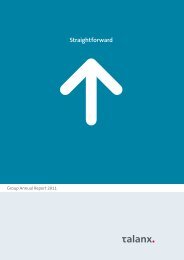Values
Values
Values
You also want an ePaper? Increase the reach of your titles
YUMPU automatically turns print PDFs into web optimized ePapers that Google loves.
Company | Group Management Group Financial | Corporate Governance | Report of the | Boards/Mandates | Additional Information<br />
Report Statements Supervisory<br />
Board<br />
Income Statement<br />
Statement of Comprehensive Income<br />
Balance Sheet<br />
Cash Flow Statement<br />
Statement of Changes in Equity<br />
Notes<br />
28 Segment Reporting<br />
Application of IFRS 8 “Operating Segments” is mandatory from<br />
January 1, 2009. Th is standard requires that external segment<br />
reporting be based on internal organizational and management<br />
structure and on management and reporting indicators<br />
used internally. Th e fi rst-time application of IFRS 8 only led<br />
to additional information in the notes for the Bertelsmann<br />
Group. It did not lead to any changes in the segments, as these<br />
already pursued the management approach in the past. Th e<br />
Bertelsmann Group comprises fi ve operating segments, which<br />
diff er according to the type of products and services they off er,<br />
and Corporate:<br />
• TV, radio and TV production group RTL Group<br />
• Global book publishing group Random House<br />
• European magazine publisher Gruner + Jahr<br />
• Media and communications service provider Arvato<br />
• Direct Group, which operates book retail and club business<br />
Each of these segments is run by a segment manager<br />
who is responsible for results. This manager reports to<br />
Bertelsmann AG’s Executive Board in its role as the chief operating<br />
decision maker within the meaning of IFRS 8. Th e Corporate<br />
division includes the Bertelsmann Group’s Corporate Center<br />
and Corporate Investments. Th e responsibilities of the<br />
Corporate Center comprise in particular activities in the areas<br />
of accounting and reporting, taxes, legal, human resources,<br />
information technology, internal auditing as well as management,<br />
internal control and strategic development of the Group,<br />
fi nancing, risk management and the optimization of the Group’s<br />
portfolio. Corporate does not constitute an operating segment.<br />
In segment reporting Corporate is shown separately.<br />
Activities not allocated to any of these divisions and multisegment<br />
link eliminations are carried in the column “Consolidation/Other.”<br />
As in the past, specifi c segment information is defi ned<br />
according to the defi nitions on which Group management<br />
is based. As a rule, accounting and valuation in the segment<br />
reporting uses the same IFRS principles as in the consolidated<br />
fi nancial statements. Deviating from the IFRS principles,<br />
66 percent of the net present value of the operating leases is<br />
considered in the caculation of invest capital. Intercompany<br />
revenues are recognized at the same arm’s-length conditions<br />
applied to transactions with third parties.<br />
Bertelsmann Annual Report 2009<br />
Th e performance of the operating segments is assessed using<br />
operating EBIT. Th is represents the operating earnings before<br />
taxes and capital costs recorded by the respective segment’s<br />
management and is calculated by adjusting EBIT for special<br />
items such as capital gains and losses, impairments, restructuring<br />
costs, severance payments and other valuation allowances.<br />
Th e elimination of these extraordinary factors allows the determination<br />
of a normalized result, thus simplifying forecasting<br />
and comparability.<br />
Segment depreciation and amortization includes the depreciation<br />
of property, plant and equipment, and amortization<br />
of intangible assets as set out in the statement of selected<br />
non-current assets.<br />
Segment assets constitute the operating assets for each<br />
segment. Th ese consist of property, plant and equipment, intangible<br />
assets including goodwill, and fi nancial assets. Also<br />
included are 66 percent of the net present value of the operating<br />
leases and current assets with the exception of cash and cash<br />
equivalents, tax receivables and other non-operating assets.<br />
Segment liabilities consist of operating liabilities and provisions.<br />
Pensions and similar obligations, tax liabilities, fi nancial<br />
debt or other non-operating liabilities and provisions are thus<br />
not included.<br />
Additions to non-current assets are balancesheet additions<br />
to property, plant and equipment and intangible assets including<br />
goodwill.<br />
Each segment shows the earnings of, and investments in,<br />
associated companies, provided these companies can be clearly<br />
allocated to the segment concerned. Th e results of associated<br />
companies are shown before impairment of goodwill.<br />
In addition, the number of employees at balance sheet<br />
date and the average number of employees for the year are<br />
shown.<br />
In addition to the segment breakdown, revenues are broken<br />
down by customer location and income source. Non-current<br />
assets are also stated according to the location of the respective<br />
company.<br />
For information on the segment information tables, please<br />
refer to page 82f.<br />
Th e following table shows the reconciliation of segment<br />
information to the consolidated fi nancial statements:<br />
143
















